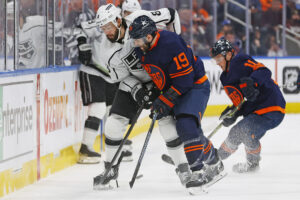The 2019-20 Toronto Maple Leafs are an enigma. On the one hand, they possess unique offensive talent. Headed by Auston Matthews, Mitch Marner and John Tavares, their forward group is among the most gifted in the game. They possess the kind of elite skill that is required to win the Stanley Cup. Yet despite having one of the top goalies in the league in Frederik Andersen, the Leafs continue to struggle to keep the puck out of their own net. They allow far too many goals. The All-Star Break presents the perfect opportunity to reflect on the team’s current state, and where it can go from here to reach its ultimate goal.
2019-20 Toronto Maple Leafs Season
Positive Change Under Sheldon Keefe
Since Mike Babcock was fired on Nov. 20, 2019, the Maple Leafs have gone 16-7-3. The team has played with renewed energy. Under new coach Sheldon Keefe, the team deploys a more modern and flexible style of play. Apparently believing that offence is their best defence, their recent game emphasizes puck possession and offensive creativity. Keefe has also focused on creating a safe environment for players involving “direct communication and transparency.”
As a result, their offensive star players are flourishing. Auston Matthews is producing at a record clip, on pace to threaten Rick Vaive’s single-season goal record. William Nylander is behaving as though he is a man freed from Babcock’s shackles. He is averaging nearly a point a game, with a presence on the team’s top power-play unit. Keefe has frequently utilized line shuffles creatively and effectively. Several times, he has successfully paired Auston Matthews with Mitch Marner, something his predecessor often stubbornly neglected to do.
Elite Offensive Statistics
Hockey analytics provide evidence of the Leafs offensive success at even strength. The Corsi For (CF) statistic measures all shots, blocks and misses for a team during the season. Corsi For Percentage (CF%) measures the control of the puck during games. High Danger Scoring Chances For (HDF) measures the number of shot attempts from the slot or rebounds. These stats are reliable indicators of puck possession, as well as the quantity and quality of offensive chances that a team generates.
In each of these statistics, the Leafs are significantly above the league average. To date, the Leafs’ CF Value is 2045. The league average is 1804. This shows that they generate far more shots than the average NHL team. They have a CF% of 53.1, indicating that they are controlling the puck significantly more often than not. The Leafs also have an HDF value of 160, well above the league average of 134. Their puck possession and shot generation is actually producing more dangerous scoring chances than average.
These statistics indicate that offensively, the Leafs are also ahead of the Boston Bruins and the Tampa Bay Lightning, their division rivals and arguably two of their main impediments to winning the Stanley Cup. The Boston Bruins numbers are: CF – 1768, CF% – 50.8%, HDF – 122. The Tampa Bay Lightning’s numbers are CF – 1813, CF% – 53%, and HDF – 142.
The Leafs have generated more quality scoring chances than either team and have possessed the puck at a higher rate. They are also scoring more goals. Since Dec. 1, 2019, they’ve averaged 4.05 goals per game, the best in the NHL.
Defensive Failures
Despite the team’s offensive success, the 2019-20 Toronto Maple Leafs have been terrible defensively. They remain among the worst in the league in goals allowed. They have allowed 3.37 goals per game, good for fourth-worst in the league. Only the hapless Detroit Red Wings, New Jersey Devils, and Ottawa Senators have been worse this season at stopping the other team from scoring.
The Leafs defensive miscues are the result of several factors. They can be careless with the puck. Sometimes, they make too many moves, hang on to the puck too long, or make poor decisions. These mistakes can cause glaring turnovers that lead to odd-man rushes. When the play progresses to their own end, the defensive zone coverage can be porous. Too often, defenders are soft on the puck, letting opposing players into dangerous areas while failing to tie up their sticks.
Because of these mistakes, the Leafs are giving up far more high percentage scoring opportunities than the league average. Those opportunities are defined as shots off rebounds or shots from the slot area. To date, the Leafs have given up 160 high danger scoring chances against. The league average is 134. The Leafs are allowing nearly twice as many high percentage opportunities as the Tampa Bay Lightning (97), and considerably more than the Boston Bruins (140).
Analysis
The Leafs’ recent defensive struggles are partly due to the change in system under Keefe. The players are learning a new system with a new coach. It will take time to learn, and growing pains are to be expected. In Keefe’s system, the Leafs appear to be trying to maximize their offensive potential. This strategy suits their existing personnel.
However, it sometimes comes at the expense of defence. An increased emphasis on puck possession is likely to produce more turnovers because players will hang on to the puck longer rather than dumping it into the offensive zone. The Leafs need to minimize the high danger scoring chances that are resulting from these turnovers. Controlling where turnovers occur, as well as paying attention to backchecking is paramount. They also need to get tougher on the puck in their own end.
It remains to be seen if the Leafs current style can work in the playoffs, where fewer penalties are called and opposing teams are more disciplined defensively. At playoff time, the Leafs are arguably vulnerable to counter-attacks, as well as physical play from other teams in their own zone.
Going Forward
One possible solution to this problem is finding responsible two-way players with grit that can skate. They could use this type of player both upfront and on defence. The Leafs have tremendous depth at the winger position. They are stocked with talented wingers at reasonable prices with similar skill sets. Moving one of these wingers for pieces that can complement the Leafs in this fashion might help the team shore up their defensive situation.
It is an old sports adage that defence wins championships. The Leafs must fix their fatal defensive flaws if they are to realize their potential. Kyle Dubas has work to do. Unless the team’s defensive prospects such as Timothy Liljegren and Rasmus Sandin immediately demonstrate that they are ready for high leverage NHL work, trades are necessary to shore up team discipline and defensive play. The season depends on it.
Main Photo:






